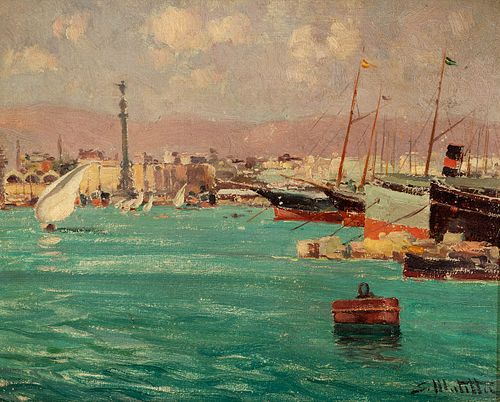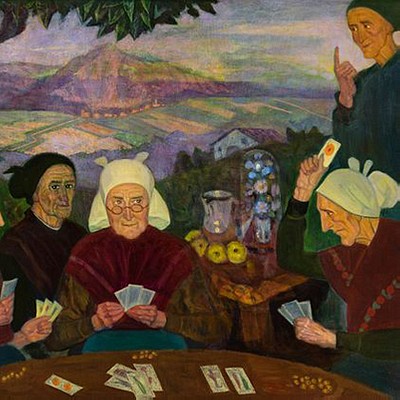SEGUNDO MATILLA MARINA (Madrid, 1862 - Teià, Barcelona, 1937). "Port of Barcelona. Oil on canvas.
Lot 72
About Seller
Setdart Auction House
Carrer Aragó 346
Barcelona
Spain
Setdart Subastas was born in 2004 and is currently the first online art auction in Spain with solidity, prestige and reliability guaranteed by our more than 60,000 users. Setdart has a young, dynamic and enterprising team ready to successfully manage the purchase and sale of art works through custom...Read more
Estimate:
EUR€4,000 - EUR€5,000
$4,301.08 - $5,376.34
Absentee vs Live bid
Two ways to bid:
- Leave a max absentee bid and the platform will bid on your behalf up to your maximum bid during the live auction.
- Bid live during the auction and your bids will be submitted real-time to the auctioneer.
Bid Increments
| Price | Bid Increment |
|---|---|
| EUR€0 | EUR€10 |
| EUR€200 | EUR€25 |
| EUR€500 | EUR€50 |
| EUR€1,000 | EUR€100 |
| EUR€3,000 | EUR€200 |
| EUR€5,000 | EUR€500 |
| EUR€10,000 | EUR€1,000 |
| EUR€20,000 | EUR€2,000 |
| EUR€50,000 | EUR€5,000 |
About Auction
By Setdart Auction House
Dec 14, 2021
Set Reminder
2021-12-14 08:00:00
2021-12-14 08:00:00
America/New_York
Bidsquare
Bidsquare : 19th & 20th Century Fine Art
https://www.bidsquare.com/auctions/setdart-auction-house/19th-20th-century-fine-art-7992
Gaudi, Sorolla, Torres Garcia, Maclet, TSUGUHARU FOUJITA, Benjamin Palencia Setdart Auction House sofia@setdart.com
Gaudi, Sorolla, Torres Garcia, Maclet, TSUGUHARU FOUJITA, Benjamin Palencia Setdart Auction House sofia@setdart.com
- Lot Description
SEGUNDO MATILLA MARINA (Madrid, 1862 - Teià, Barcelona, 1937). "Port of Barcelona. Oil on canvas. Retains label on the back of Barrachina and Ramoneda. Signed in the lower right corner. Measurements: 27 x 35 cm; 44 x 52 cm (frame). Segundo Matilla made numerous views of the port of Barcelona, capturing the landscape from numerous perspectives. In this particular case, the artist configures the landscape in different horizontal sections, to which he gives independent spaces that harmonize and merge with each other, forming a landscape of pastel tones that provide a quality and relaxing atmosphere. Despite being born in Madrid, Matilla trained and developed his career in Barcelona. He studied at the School of Fine Arts in Barcelona, under the direction of Antonio Caba. He participated in numerous exhibitions, such as the International Exhibition of Barcelona in 1891, 1894, 1896 and 1898 (honorable mention in 1891), the Art Exhibitions of the same city in 1918 and 1919, and in the Paris Salon of 1897. That same year he obtained an honorable mention at the National Exhibition of Fine Arts in Madrid. Among his individual exhibitions were those held at the Salón Vilches in Madrid (1915) and, in Barcelona, at the Sala Parés (1914) and the Pallarés Galleries (1942), the latter a posthumous tribute. Several of his works exhibited there were bought by the Museum of Modern Art in Madrid, and many others were exported to America. He achieved great public and critical success thanks to his landscapes of the Empordà, Camprodón, Port de la Selva and Cadaqués. A painter endowed with astonishing skill, a marked personality full of sensitivity, a mastery of drawing and pictorial technique and an overflowing capacity for work, Segundo Matilla was an excellent painter who cultivated absolutely all genres, being a great landscape and marine painter, painting portraits of great quality, especially of people from the world of show business, and his vases and still lifes were also highly appreciated. His paintings of bullfighting themes, painted with great spontaneity and full of movement, demonstrate his great fondness for the art of Cúchares. He always painted in a totally intelligible way and without any kind of reflexive complications, ignoring absolutely all the artistic trends of his time. His work can be found in various museums, such as the aforementioned Museum of Contemporary Art in Madrid, the Prado Museum, the Pablo Gargallo Museum in Zaragoza and the National Art Museum of Catalonia, as well as in important international private collections.
- Shipping Info
-
In-house shipping available. Please inquire at admin@setdart.com.
-
- Buyer's Premium



 EUR
EUR CAD
CAD AUD
AUD GBP
GBP MXN
MXN HKD
HKD CNY
CNY MYR
MYR SEK
SEK SGD
SGD CHF
CHF THB
THB
















